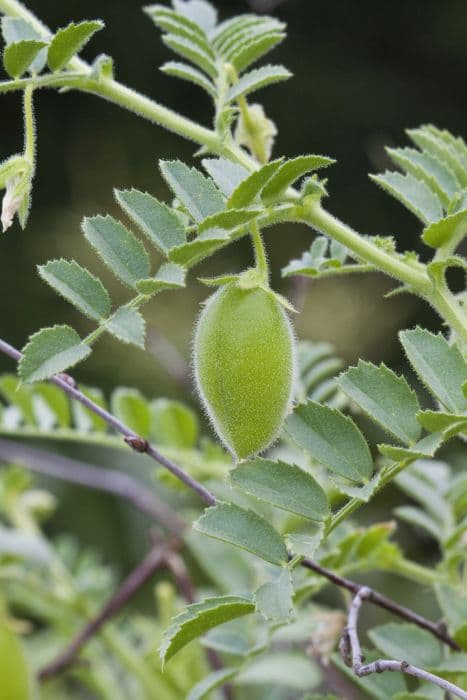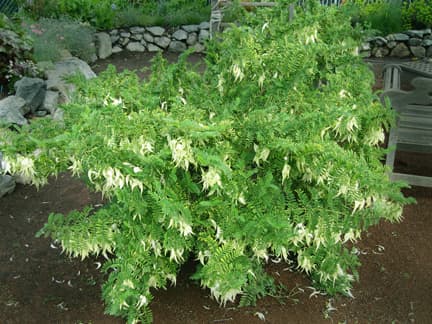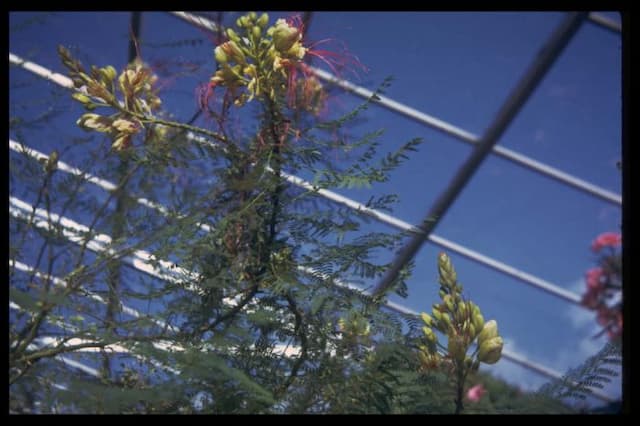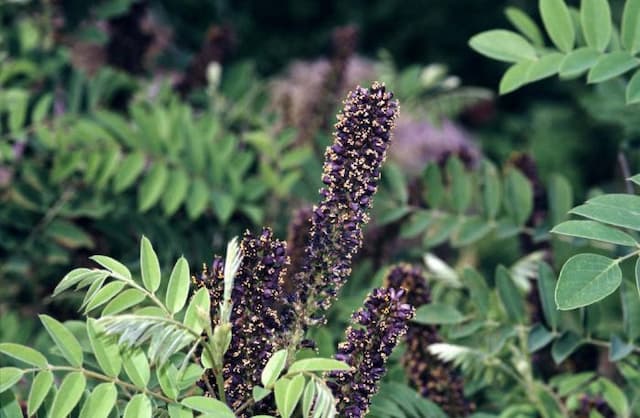Golden Chain Tree Laburnum anagyroides
ABOUT
Laburnum anagyroides, widely known as the common laburnum, is a striking plant renowned for its cascades of vibrant yellow flowers. The plant has a distinctive woody stem that supports a branching structure. Its bark is often dark brown and can have a somewhat rough texture with age. The leaves are trifoliate, meaning each leaf is composed of three leaflets which are finely textured and have a bright green hue on top, while the underside is a paler green. One of the most spectacular features of the common laburnum is its abundant flower display. The flowers dangle in pendulous racemes that can be quite long, creating an eye-catching golden-yellow waterfall effect. These blossoms are bright and showy, drawing attention from a distance with their cheerful color. Typically, they bloom in late spring to early summer, and their sweet scent can attract various pollinators to the garden. Once the flowering season concludes, the plant produces pods that house the seeds. These pods can be somewhat elongated, resembling the shape of a pea pod. While the pods provide an additional element of visual interest through the seasons, it's essential to note that all parts of the laburnum are toxic if ingested, and care should be taken, especially around children and pets. The overall appearance of the common laburnum is one that can bring a splash of color to a garden when in bloom. Its graceful and lush flower drapes offer a magnificent display that contrasts beautifully against its dark bark and green foliage, making it a favorite for ornamental purposes. Despite the need for caution due to its toxicity, it remains a popular choice for adding a dramatic flourish to the landscape.
About this plant
 Names
NamesFamily
Fabaceae
Synonyms
Golden Chain, Golden Rain, Bean Tree
Common names
Cytisus laburnum, Laburnum vulgare
 Toxicity
ToxicityTo humans
The common name for Laburnum anagyroides is Golden Chain or Golden Rain. This plant is highly toxic to humans if any part is ingested. It contains a compound called cytisine, similar to nicotine, which can cause severe poisoning. Symptoms of poisoning may include nausea, vomiting, convulsions, diarrhea, and in extreme cases, can lead to coma or even death due to respiratory failure. It is important to ensure children do not ingest any part of the Golden Chain, as its seed pods, which resemble pea pods, can be particularly attractive but are highly poisonous.
To pets
Golden Chain, the common name for Laburnum anagyroides, poses a significant threat to pets if ingested. All parts of the plant are toxic to animals, including dogs and cats. The toxic compound, cytisine, can cause symptoms such as vomiting, diarrhea, and in severe cases, convulsions, respiratory failure, and could potentially be fatal. Its seed pods, which might appeal to pets, are especially dangerous. Pet owners should prevent their animals from coming into contact with any part of the Golden Chain plant.
 Characteristics
CharacteristicsLife cycle
Perennials
Foliage type
Deciduous
Color of leaves
Green
Flower color
Yellow
Height
20 feet (6 meters)
Spread
20 feet (6 meters)
Plant type
Tree
Hardiness zones
5
Native area
Europe
Benefits
 General Benefits
General Benefits- Ornamental value: Golden chain tree is prized for its vibrant yellow flowers that hang in pendulous racemes, providing a spectacular display in spring and early summer.
- Habitat support: The flowers produce nectar and pollen, which attract pollinators such as bees and butterflies, supporting local ecosystems.
- Shade provision: As a medium-sized tree, it can offer a moderate amount of shade, making it suitable for planting in gardens and parks.
- Cultural significance: In certain cultures, the tree is valued for its symbolic meaning or used in celebrations, such as being associated with the Victorian symbolism for forsaken or pensive beauty.
- Education and research: It can be used in educational settings like botanical gardens to teach about plant biology, taxonomy, and the importance of plant diversity.
- Source of wood: Although not a primary timber tree, its wood can be used for crafting small wooden objects and in inlay work due to its hardness and durability.
 Medical Properties
Medical Properties- Emetic: Traditionally, the plant has been used to induce vomiting in cases of poisoning.
- Purgative: Some historical references suggest its use as a purgative to cleanse the digestive tract.
- Narcotic: In folk medicine, it has been used for its narcotic effects.
 Air-purifying Qualities
Air-purifying QualitiesThis plant is not specifically known for air purifying qualities.
 Other Uses
Other Uses- Woodworking: Laburnum, also known as Golden Chain, wood is dense and has a fine grain, making it suitable for cabinet making, turning, and inlay work.
- Ornamental Carving: Due to its hardness and the fact that it polishes well, Laburnum wood can be used for ornamental carvings, including decorative boxes and chess pieces.
- Dye Production: Laburnum bark and flowers can be used to produce a yellow dye for textiles.
- Inlay Material: The dark wood of the Laburnum is prized for its use as inlay in decorative flooring, furniture, and musical instruments due to its contrasting color.
- Garden Architecture: Laburnum trees can be trained into architectural forms such as arbors or tunnels, creating dramatic floral displays in gardens.
- Educational Use: The distinctive seed pods and flowers of the Laburnum can be used in schools for botanical studies and educational displays.
- Photography: The vibrant yellow flowers of the Golden Chain tree are a popular subject for photographers, especially when in full bloom.
- Wood Turning: The fine-grained wood of Laburnum is well-suited for creating intricate turned objects like bowls, pens, and goblets.
- Specialty Veneer: Laburnum wood can be sliced into thin veneers, used in fine woodworking and luxury applications where its unique appearance is valued.
- Framework for Climbing Plants: The sturdy branches of Laburnum trees can be used as a natural frame to support the growth of climbing plants such as roses or clematis.
Interesting Facts
 Feng Shui
Feng ShuiThe Golden Chain Tree is not used in Feng Shui practice.
 Zodiac Sign Compitability
Zodiac Sign CompitabilityThe Golden Chain Tree is not used in astrology practice.
 Plant Symbolism
Plant Symbolism- Passing of Youth: The golden chain tree, with its bright yellow blossoms, symbolizes the fleeting nature of youth and beauty, much like its flowers that bloom vibrantly but do not last long.
- Beware of Appearances: Its attractive flowers belie the fact that the entire plant is toxic, which can be seen as a lesson that not everything that looks appealing is necessarily good for us.
- Danger and Poison: As Laburnum anagyroides is highly poisonous, it has become a symbol of danger and the presence of something lethal beneath a beautiful exterior.
- Pride: Sometimes, the golden chain tree is associated with pride due to its showy cascades of flowers that stand out in the landscape.
 Water
WaterGolden Chain Trees should be watered regularly but be sure to allow the soil to dry out somewhat between waterings. Typically, an established tree requires watering once every week or two, depending on the climate and soil conditions. For young trees, provide about 2 gallons per inch of trunk diameter each time you water. During hot or dry spells, increase watering frequency to prevent stress. Less water is required during the dormant season; reduce watering to every few weeks, or as needed to prevent soil from becoming completely dry.
 Light
LightGolden Chain Trees thrive in full sun to partial shade. The ideal spot would receive sunlight for at least six hours a day, which encourages the best flowering. They can tolerate slight shade, but too much shade can reduce the abundance of the blooms and can lead to a sparser canopy.
 Temperature
TemperatureGolden Chain Trees prefer moderate climates and do best with temperatures ranging from 60°F to 75°F during the growing season. They can withstand winter temperatures down to around 0°F but should be protected from severe frosts. The plant performs poorly in extreme heat, so regions with temperatures consistently above 80°F are less suitable for the Golden Chain Tree.
 Pruning
PruningPrune Golden Chain Trees to maintain their shape and remove any dead or diseased branches, which will also encourage new growth. The best time for pruning is in late winter or early spring before the new leaves appear. Minimal pruning is generally required; do this task every 2 to 3 years to keep the tree tidy and healthy.
 Cleaning
CleaningAs needed
 Soil
SoilGolden Chain Tree prefers well-drained soil with a pH range of 6.0 to 7.5. A soil mix comprising loam, sand, and compost in equal parts creates an ideal growing medium for this plant, ensuring adequate nutrition and proper drainage to foster health and reduce the risk of root rot.
 Repotting
RepottingGolden Chain Trees are typically grown outdoors and do not need regular repotting; only transplant seedlings or young plants when they outgrow their current space, which can be every few years.
 Humidity & Misting
Humidity & MistingGolden Chain Tree tolerates a wide range of humidity levels and does not have specific humidity requirements, making it adaptable to various outdoor environments without the need for controlled humidity conditions.
 Suitable locations
Suitable locationsIndoor
Golden Chain Trees are not suitable for indoor cultivation due to size.
Outdoor
Plant Golden Chain Tree in full sun, well-drained soil; tall space needed.
Hardiness zone
5-7 USDA
 Life cycle
Life cycleThe life of the Common Laburnum (Laburnum anagyroides) begins with the germination of the seed, which usually occurs in the spring following a period of dormancy and chilling over the winter. Upon germination, the seedling emerges and develops into a young plant, initially establishing a root system and a rosette of leaves. As the plant matures, it grows into a small tree with a branching habit, and after a few years, it becomes capable of flowering, usually around late spring to early summer. The flowers are yellow, pea-like, and hang in pendulous racemes, attracting pollinators such as bees. After pollination, the flowers develop into seed pods (legumes) that mature by late summer, then dry and split open to release the seeds. The plant then goes into senescence in the winter, ceasing growth and dropping leaves, awaiting the next growing season to repeat its cycle.
 Propogation
PropogationPropogation time
Spring-Early Summer
Propogation: The most common method of propagating Laburnum anagyroides, commonly known as Golden Chain Tree, is by seed. Golden Chain Tree seeds are best sown in the fall directly into the ground where they are to grow. After collecting the seed pods in late summer, allow them to dry so they can release their seeds. Sow the seeds in a sunny location in well-drained soil, planting them at a depth of about an inch (2.54 cm). The seeds of the Golden Chain Tree have a hard outer coating, which means they'll benefit from a process called scarification before planting. This involves gently scratching the seed coat to encourage germination. Once planted, the seeds will overwinter and typically germinate in the spring when the soil warms up.









